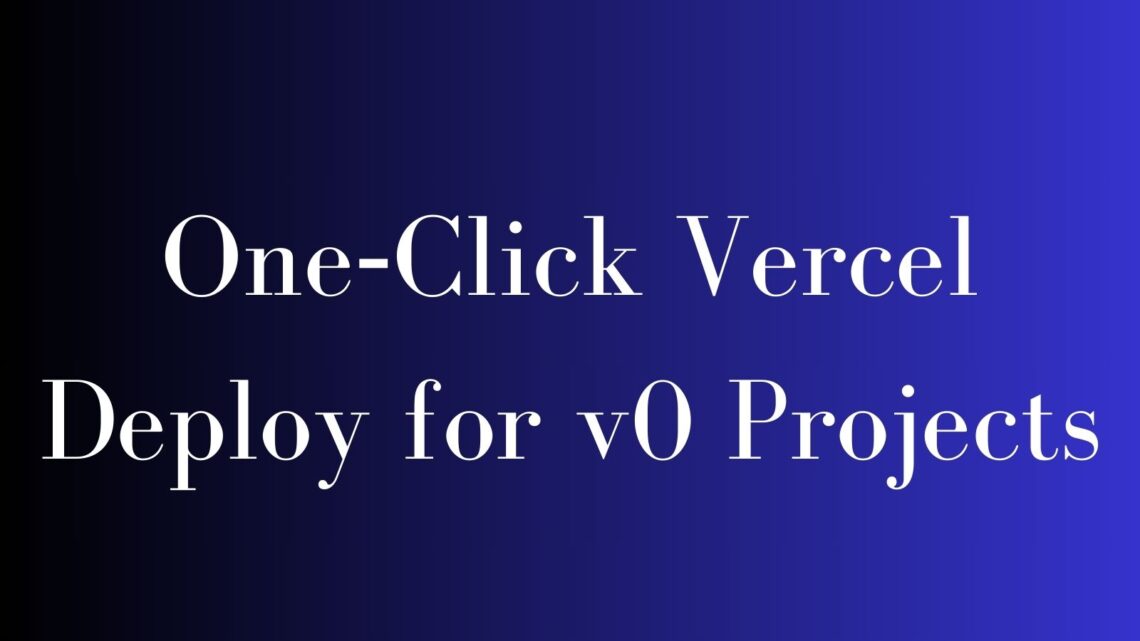One of the most powerful features of v0.dev is its seamless One-Click Deploy to Vercel. This lets you preview your generated app instantly on a live URL, without any setup. But if you want to scale, collaborate, or deploy production-ready apps, there’s a bit more to it. Let’s break down how to go from one-click preview to professional CI/CD workflows.
One-Click Deploy from v0 to Vercel: How It Works
Clicking Deploy in v0.dev packages your app and sends it to Vercel, where it’s live in seconds at a *.vercel.app URL. This one-click deploy creates a new Vercel project (prefixed with v0-) and updates that project each time you deploy.
Things to know:
- The project isn’t tied to a Git repo by default.
- Code changes in v0 aren’t synced unless you redeploy.
- Perfect for demos—not ideal for production.
One v0 user put it best: “Use the one-click deploy for quick previews. For production, export the code and set up GitHub + Vercel CI/CD.” (source: reddit.com)
Connecting Your v0 Project to GitHub (Continuous Deployment)
If you’re planning to iterate, collaborate, or go live, connecting to GitHub is essential. Here’s the flow:
- Export the code
- Click Add to Codebase in v0.
- Follow the instructions (e.g.,
npx v0 addor Download ZIP). - Workaround: if the button fails, manually copy/paste.
- Create a GitHub repo
- Push your code like any normal project.
- Import to Vercel
- In the Vercel dashboard, click Add New → Project.
- Connect your GitHub account.
- Select your repo and let Vercel detect the framework (usually Next.js).
- (Optional) Link to existing v0-generated project
- In Vercel Settings > Git, link your new repo.
- This updates the existing
v0-project instead of creating a new one.
By doing this, you unlock continuous deployment—each push to GitHub triggers a live build.
Setting Up Environment Variables on Vercel
v0 apps often require API keys or DB connections. These go into Vercel’s Environment Variables:
- Navigate to Vercel > Project > Settings > Environment Variables
- Add each key: Name, Value, and Scope (Development, Preview, Production)
- Example:
NEXT_PUBLIC_API_KEY,DATABASE_URL - Values are encrypted and safe
Tip: If a key is missing, v0 might prompt you. Make sure the project is linked to Vercel so env vars can sync correctly (source: community.vercel.com).
Preview vs Production Deployments on Vercel
Vercel uses branch-based deployments to separate preview and production:
- Production: linked to
mainbranch or custom domain - Preview: linked to PRs or feature branches
Every push outside main gets a unique preview URL—great for testing.
Customize environment variables per environment. Want test API keys on previews but real keys on production? You can do that.
You can even promote previews to production without merging. Just find the deployment in the dashboard, click ⋯, and hit Promote to Production.
Rolling Back Deployments
Something broke in production? You’ve got options:
- Instant Rollback
- In the Deployments tab, find a previous prod build.
- Click
⋯> Promote to Production. Done. (No rebuild required.)
- Revert in Git
- Use
git revertand push. Triggers a clean rebuild.
- Use
- Vercel CLI
- Run:
vercel rollback <deployment-url>
- Run:
On Hobby plans, you can only roll back one step. Pro plans unlock deeper history.
FAQ
How Do I Export My V0.Dev Project To Github?
Click Add to Codebase in v0, download the ZIP or use the npx v0 add command. Then create a GitHub repo, push the code, and import it into Vercel.
Why Isn’T My V0 Site Updating After Deploy?
One-click deploy snapshots the app. To reflect new changes, hit Deploy again in v0, or use a GitHub workflow for continuous updates.
Where Do I Add My Api Keys For A V0 Project?
Go to Vercel dashboard > Settings > Environment Variables. Use correct casing (NEXT_PUBLIC_ for client-side) and scope them properly.
How Do I Roll Back A Broken Deploy On Vercel?
Use the dashboard’s Instant Rollback or Promote Previous Deployment. Free plans allow one-step rollback; Pro allows full history.

